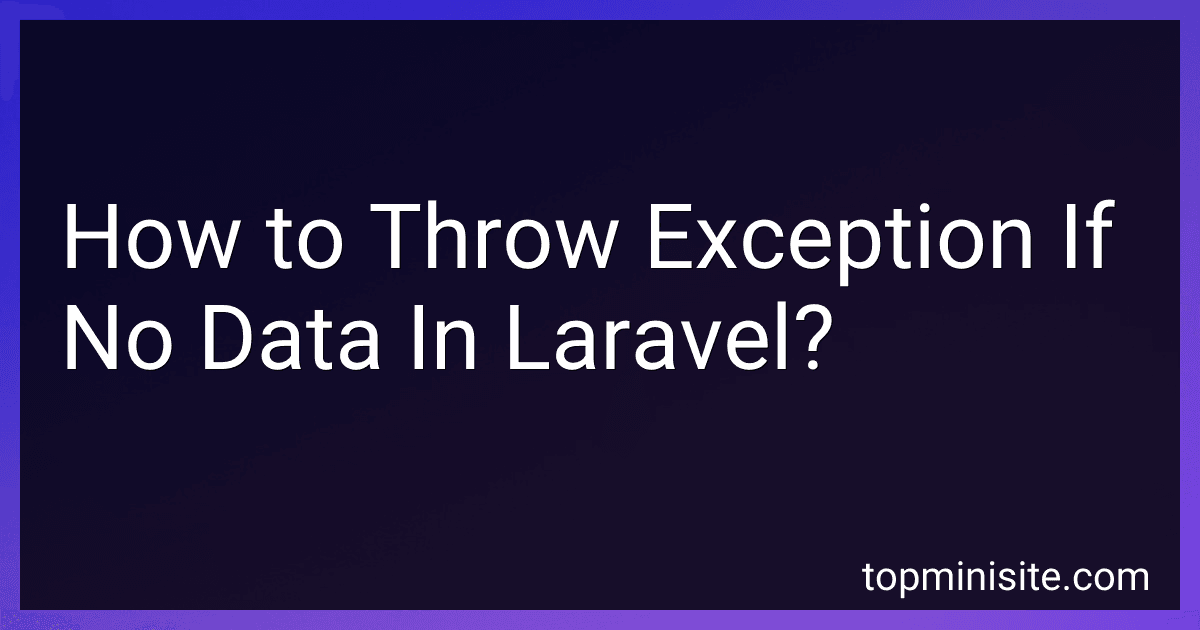Best Laravel Exception Handling Techniques to Buy in December 2025
In Laravel, you can throw an exception if no data is found by using the findOrFail() or firstOrFail() methods. These methods will automatically throw a ModelNotFoundException if no results are found, allowing you to catch the exception and handle it appropriately in your code. You can also manually throw a custom exception using the abort() or throw_if() methods if needed. By handling exceptions in this way, you can ensure that your application gracefully handles cases where no data is available, providing a better user experience.
How to handle database exceptions in Laravel for missing data?
To handle database exceptions in Laravel for missing data, you can use the try-catch block in your code. Here's an example of how you can handle a ModelNotFoundException exception which occurs when trying to access data that does not exist in the database:
use App\Models\User; use Illuminate\Database\Eloquent\ModelNotFoundException;
try { $user = User::findOrFail($userId); // Do something with the user data } catch (ModelNotFoundException $e) { // Handle the exception, for example return a response with a 404 status code return response()->json(['error' => 'User not found'], 404); }
In this example, we are trying to find a user with a specific $userId. If the user is not found, a ModelNotFoundException exception will be thrown and caught in the catch block. You can then handle the exception by returning a response to the user indicating that the requested data was not found.
You can customize the exception handling logic based on your application's requirements. You can also log the exception details for debugging purposes using Laravel's logging features.
What is the significance of data validation in Laravel exception handling?
Data validation in Laravel exception handling is significant because it helps to ensure that the data inputted by the user is in the correct format and meets certain criteria before it is processed further in the application. This helps to prevent errors, security vulnerabilities, and other issues that may arise from invalid or malformed data being passed through the application.
By adding data validation rules in Laravel, developers can easily define the criteria that data must meet before it can be accepted and processed. If the input data does not pass the validation rules, Laravel will automatically throw a validation exception, which can be caught and handled within the application. This helps to prevent invalid data from causing unexpected errors or issues in the application and provides a better user experience.
Overall, data validation in Laravel exception handling is essential for ensuring the integrity and security of the application, and for improving its overall stability and reliability.
What is the recommended way to log exceptions in Laravel?
In Laravel, the recommended way to log exceptions is to use the report() method within the App\Exceptions\Handler class. The report() method accepts an exception as a parameter and should be used to log or report the exception to services like Bugsnag, Sentry, etc. This method is automatically called by Laravel when an exception is caught.
Additionally, Laravel provides a log() method that can be used within the App\Exceptions\Handler class to write exceptions to the log file. This method can be used to log exceptions with custom logic or formatting.
It is generally recommended to use both the report() and log() methods to ensure that exceptions are properly logged and reported. Additionally, using services like Bugsnag or Sentry can provide more detailed information and context about the exception, making it easier to debug and resolve issues.
What is the outcome of not handling missing data in Laravel?
Not handling missing data in Laravel can lead to various issues such as errors, unexpected behavior, and incorrect or incomplete data being displayed to users. It can also make the application more vulnerable to security risks such as injection attacks or data leaks. It is important to properly handle missing data in order to ensure the stability and security of the application.
What is the significance of throwing exceptions for no data scenario in Laravel?
Throwing exceptions for no data scenario in Laravel is significant for several reasons:
- Error handling: By throwing an exception when no data is found, you can easily catch the exception and handle it appropriately in your code. This allows you to provide a more user-friendly error message or redirect the user to a different page.
- Code clarity: Throwing an exception makes it clear that your application is unable to retrieve the data it needs. This can help you identify and fix potential issues in your code more easily.
- Prevents null or empty data: By throwing an exception, you can prevent your application from returning null or empty data, which can lead to unexpected behavior and errors down the line.
- Consistency: By consistently throwing exceptions for specific scenarios, you can maintain a standard error handling approach throughout your application, making it easier to understand and debug.
Overall, throwing exceptions for no data scenarios in Laravel helps improve the reliability, maintainability, and user experience of your application.
